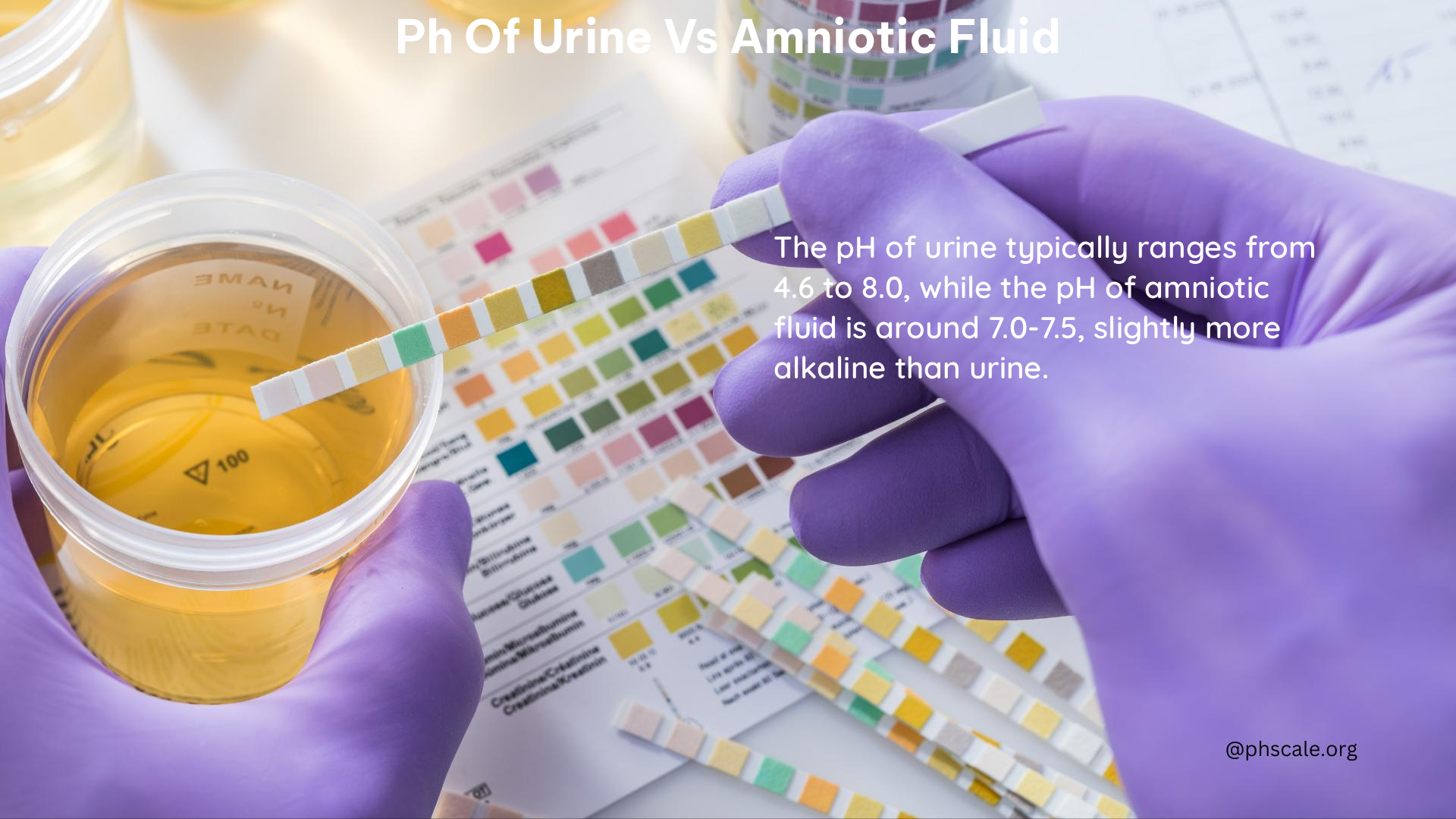The pH of urine and amniotic fluid are distinct and can be used to differentiate between the two. While urine typically has a pH range of 4.0 to 8.3, amniotic fluid has a higher pH, generally ranging from 7.0 to 7.5. This difference in pH is a crucial factor in accurately diagnosing various medical conditions, particularly during pregnancy.
Understanding the pH of Urine
Urine is a complex fluid produced by the kidneys, and its pH can vary depending on various factors. The average pH of urine is around 6.0, but it can range from 4.0 to 8.3. This variation is influenced by factors such as diet, medications, and the body’s acid-base balance.
Factors Affecting Urine pH
- Diet: The foods and beverages we consume can impact the pH of our urine. For example, a diet high in acidic foods, such as citrus fruits or protein-rich foods, can lower the pH of urine.
- Medications: Certain medications, such as antibiotics or diuretics, can also affect the pH of urine.
- Acid-Base Balance: The body’s ability to maintain a healthy acid-base balance can influence the pH of urine. Conditions like metabolic acidosis or respiratory acidosis can lead to a lower urine pH.
Amniotic Fluid pH: A Distinct Characteristic

Amniotic fluid is the liquid that surrounds the fetus during pregnancy. This fluid plays a crucial role in the development and protection of the unborn child. The pH of amniotic fluid is generally higher than that of urine, typically ranging from 7.0 to 7.5.
Factors Affecting Amniotic Fluid pH
- Gestational Age: The pH of amniotic fluid can vary slightly throughout the course of pregnancy, with higher pH values observed as the pregnancy progresses.
- Fetal Maturity: The pH of amniotic fluid is also influenced by the maturity of the fetus, with more mature fetuses generally having a higher pH.
- Maternal Health: Certain maternal health conditions, such as diabetes or preeclampsia, can impact the pH of amniotic fluid.
Distinguishing Between Urine and Amniotic Fluid
The difference in pH between urine and amniotic fluid can be used to differentiate between the two fluids, which is particularly important in certain medical situations.
pH Testing Methods
- Litmus Test: Litmus paper or strips can be used to quickly assess the pH of a fluid. If the pH is above 6.5, it is likely amniotic fluid.
- pH Meters: More precise pH measurements can be obtained using electronic pH meters, which provide a numerical value for the pH of the fluid.
Accuracy and Limitations
While pH testing can be a useful tool, it is important to note that false positives or negatives can occur due to various factors, such as antibiotic therapy, infections, or contamination with blood or semen. Therefore, healthcare professionals may use additional tests or clinical assessments to confirm the diagnosis.
Practical Applications of pH Differences
The distinct pH characteristics of urine and amniotic fluid have several practical applications, particularly in the field of obstetrics and gynecology.
Diagnosing Premature Rupture of Membranes (PROM)
One of the primary uses of pH testing is in the diagnosis of PROM, a condition where the amniotic sac ruptures before the onset of labor. By identifying the presence of amniotic fluid through a higher pH, healthcare providers can initiate appropriate medical interventions to prevent complications and ensure the well-being of the mother and baby.
Home Testing Kits
In recent years, home testing kits, such as AmnioSense, have been developed to allow women to check for the presence of amniotic fluid in the event of unexplained vaginal wetness. These kits use pH-dependent color-changing strips to provide a non-invasive and convenient method for detecting amniotic fluid leakage.
Conclusion
The pH of urine and amniotic fluid are distinct characteristics that can be used to differentiate between the two fluids. Understanding these differences is crucial in various medical situations, particularly during pregnancy, where accurate diagnosis of amniotic fluid leakage can have significant implications for the health and well-being of the mother and child.
References:
– BabyCenter. (n.d.). Leaking amniotic fluid (premature rupture of membranes). Retrieved from https://www.babycenter.com/pregnancy/health-and-safety/leaking-amniotic-fluid-premature-rupture-of-membranes_40007984
– OGP News. (2017, August 4). New technology helps identify amniotic fluid leakage. Retrieved from https://www.ogpnews.com/2017/08/new-technology-helps-identify-amniotic-fluid-leakage/22427
– NICE. (2019, November 26). AmnioSense for unexplained vaginal wetness in pregnancy. Retrieved from https://www.nice.org.uk/advice/mib198/resources/amniosense-for-unexplained-vaginal-wetness-in-pregnancy-pdf-2285963765213893
– TestMenu. (2021, August 19). pHizatest for Vaginal pH Testing (pH range 4.5-7.5). Retrieved from https://www.testmenu.com/zsfglab/TestDirectory/SiteFile?fileName=sidebar%5CVaginal+pH+test+by+pHizatest+Paper.pdf
– Reddit. (2018, January 27). Tip: Amniotic fluid or just urine? Retrieved from https://www.reddit.com/r/BabyBumps/comments/7tbysn/tip_amniotic_fluid_or_just_urine/.
